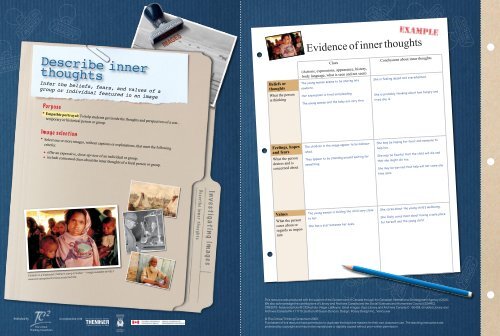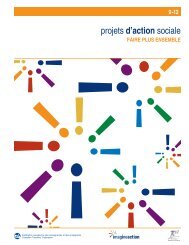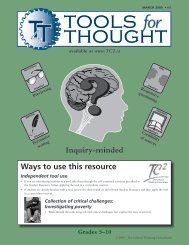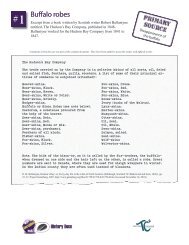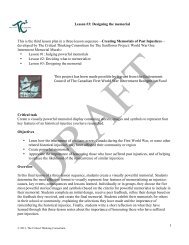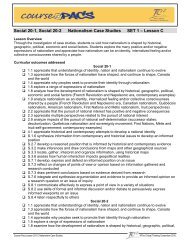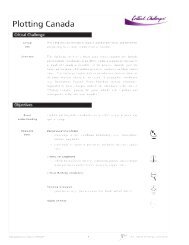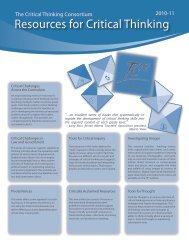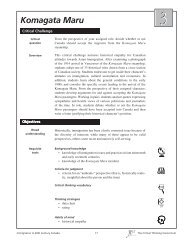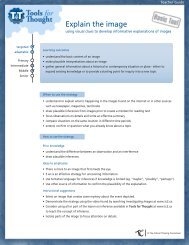Describe inner thoughts - Source Docs - The Critical Thinking ...
Describe inner thoughts - Source Docs - The Critical Thinking ...
Describe inner thoughts - Source Docs - The Critical Thinking ...
Create successful ePaper yourself
Turn your PDF publications into a flip-book with our unique Google optimized e-Paper software.
INVESTIGATING<br />
IMAGES<br />
INVESTIGATING<br />
IMAGES<br />
INVESTIGATING<br />
IMAGES<br />
<strong>Describe</strong> <strong>inner</strong><br />
<strong>thoughts</strong><br />
Infer the beliefs, fears, and values of a<br />
group or individual featured in an image<br />
Purpose<br />
• Empathic portrayal: To help students get inside the <strong>thoughts</strong> and perspectives of a con-<br />
Beliefs or<br />
<strong>thoughts</strong><br />
What the person<br />
is thinking<br />
Clues<br />
(Actions, expressions, appearance, history,<br />
body language, what is seen and not seen)<br />
<strong>The</strong> young woman seems to be staring into<br />
nowhere.<br />
Her expression is tired and pleading.<br />
<strong>The</strong> young woman and the baby are very thin.<br />
INVESTIGATING<br />
IMAGES<br />
Evidence of <strong>inner</strong> <strong>thoughts</strong><br />
Conclusions about <strong>inner</strong> <strong>thoughts</strong><br />
She is feeling dazed and overwhelmed.<br />
INVESTIGATING<br />
IMAGES<br />
She is probably thinking about how hungry and<br />
tried she is.<br />
INVESTIGATING<br />
IMAGES<br />
temporary or historical person or group.<br />
Image selection<br />
•<br />
Select one or more images, without captions or explanations, that meet the following<br />
criteria:<br />
◆<br />
◆<br />
offer an expressive, close-up view of an individual or group;<br />
include contextual clues about the <strong>inner</strong> <strong>thoughts</strong> of a focal person or group.<br />
Feelings, hopes<br />
and fears<br />
What the person<br />
desires and is<br />
concerned about<br />
<strong>The</strong> children in the image appear to be malnourished.<br />
<strong>The</strong>y appear to be standing around waiting for<br />
something.<br />
She may be hoping for food; and someone to<br />
help her.<br />
She may be fearful that the child will die and<br />
that she might die too.<br />
She may be worried that help will not come any<br />
time soon.<br />
Children in a displaced children’s camp in Sudan — Image available at http://<br />
www.tc2.ca/wp/electronicsourcebook/cida<br />
De s c r i b e i n n e r t h o u gh t s<br />
I n ve s t i g a t i n g i m age s<br />
Values<br />
What the person<br />
cares about or<br />
regards as important<br />
<strong>The</strong> young woman is holding the child very close<br />
to her.<br />
She has a scar between her eyes.<br />
IMAGES<br />
INVESTIGATING<br />
She cares about the young child’s wellbeing.<br />
She likely cares most about having a safe place<br />
for herself and the young child.<br />
INVESTIGATING<br />
IMAGES<br />
IMAGES<br />
INVESTIGATING<br />
INVESTIGATING<br />
IMAGES<br />
Published by<br />
in conjunction with<br />
This resource was produced with the support of the Government of Canada through the Canadian International Development Agency (CIDA).<br />
We also acknowledge the contributions of Library and Archives Canada and the Social Sciences and Humanities Council (SSHRC).<br />
CREDITS: Featured photo:© CIDA photo: Roger LeMoyne. Small images: (top) Library and Archives Canada C-150429; (middle) Library and<br />
Archives Canada PA-111710; (bottom) © Susan Duncan. Design: Poissy Design Inc., Vancouver<br />
© <strong>The</strong> <strong>Critical</strong> <strong>Thinking</strong> Consortium 2009<br />
Purchasers of this resource have permission to duplicate the blackline masters for their own classroom use. <strong>The</strong> teaching instructions are<br />
protected by copyright and may not be reproduced or digitally copied without prior written permission.
© <strong>The</strong> <strong>Critical</strong> <strong>Thinking</strong> Consortium 2009<br />
INVESTIGATING<br />
IMAGES<br />
INVESTIGATING<br />
IMAGES<br />
Instructions<br />
INVESTIGATING<br />
IMAGES<br />
• Introduce <strong>inner</strong> thinking: Invite students to play a game with you in which they have to determine<br />
what you are thinking or “read” your mind. Begin with actions such as wringing your hands, frowning,<br />
looking slowly from side to side. Ask students what you might be thinking. Students might suggest<br />
that you are nervous, anxious, or worried. Discuss with students the clues that helped them reach these<br />
conclusions. Suggestions might include facial expressions, body position, and hand gestures. Provide<br />
another example of your own or invite a student to indicate signs of an <strong>inner</strong> thought. Encourage students<br />
to identify visual clues that reveal what the person might be thinking. Using student ideas, explain that<br />
<strong>inner</strong> <strong>thoughts</strong> may refer to the following:<br />
beliefs (what the person is thinking);<br />
fears (what the person is concerned about or afraid of);<br />
values (what the person regards as important).<br />
◆<br />
◆<br />
◆<br />
• Distribute the image(s): Use the image featured on the previous page or another image to demonstrate the<br />
activity before students investigate other images independently. Provide pairs of students with the sample<br />
image or display the image on a screen. Allow two or three minutes for each pair to discuss what it sees. As<br />
a class, briefly review the main details of the image.<br />
• Introduce the task: Explain to students that their task is to use visual<br />
clues—direct observations from the image—to draw conclusions about<br />
the <strong>inner</strong> thinking of one of the individuals. Remind students that facial<br />
expressions and body language may reveal beliefs, fears, and values.<br />
Provide an example of a direct observation from the image and an inference.<br />
For example, the young woman’s look of determination while<br />
closely holding the child might be suggest fear for the child’s safety or<br />
health. Explain that the observation or clue provides the evidence for the<br />
conclusion. Caution students that we cannot know for sure what another<br />
person is thinking, but we can use clues to draw reasonable conclusions<br />
about possible feelings. Provide students with a copy of Evidence of<br />
<strong>inner</strong> <strong>thoughts</strong>.<br />
• Look for clues: Guide students in recording multiple details that serve<br />
as clues to the beliefs and <strong>thoughts</strong>, feelings, hopes, fears, and values of<br />
an individual featured in the image. Encourage students to begin with the<br />
most obvious clues and then look for more subtle or less obvious clues.<br />
Prompt students to consider elements such as physical stance, physical<br />
appearance, context or location of the image, facial expression, and to<br />
examine specific details such as eyes, forehead, mouth, and head position.<br />
Evidence of <strong>inner</strong> <strong>thoughts</strong><br />
Name: _______________________________________<br />
Image: _______________________________________<br />
Beliefs or<br />
<strong>thoughts</strong><br />
Wha the person<br />
is thinking<br />
Feelings, hopes<br />
and fears<br />
Wha the person<br />
desires and is<br />
concerned about<br />
Values<br />
Wha the person<br />
cares about or<br />
regards as important<br />
Use with <strong>Describe</strong> <strong>inner</strong> <strong>thoughts</strong><br />
Clues<br />
(Actions, expressions, appearance, history, body<br />
language, what i seen and not seen)<br />
© <strong>The</strong> <strong>Critical</strong> <strong>Thinking</strong> Consortium 2009<br />
Conclusions about <strong>inner</strong> <strong>thoughts</strong><br />
Criteria for e fective descriptions of <strong>inner</strong> <strong>thoughts</strong><br />
Accurate and specific clues: identifies accurate and<br />
precise clues from the image abou the person’s beliefs,<br />
fears, and values;<br />
Plausible and insightful conclusions: o fers believable<br />
conclusions that go beyond what is obvious in the image<br />
to provide a revealing impre sion of the person’s <strong>inner</strong><br />
<strong>thoughts</strong>.<br />
Before working independently,<br />
confirm that students can identify<br />
a few relevant details in the image.<br />
INVESTIGATING<br />
IMAGES<br />
• Discuss criteria: Discuss with students what makes an effective description of a person’s <strong>inner</strong> <strong>thoughts</strong>. If<br />
necessary provide examples of conclusions that are not good such as “<strong>The</strong> girl is happy”, and observations<br />
that may be accurate but lack insight such as “<strong>The</strong> mother has a child.” Invite students to explain why these<br />
descriptions are not satisfactory. Based on this discussion, introduce the following criteria:<br />
accurate and specific clues: identifies accurate and precise clues from the image about the person’s<br />
beliefs, fears, and values;<br />
plausible and insightful conclusions: offers believable conclusions<br />
that go beyond what is obvious in the image to provide a revealing<br />
impression of the person’s <strong>inner</strong> <strong>thoughts</strong>.<br />
◆<br />
◆<br />
• Draw conclusions: Guide students in using the clues to indicate<br />
conclusions about the <strong>inner</strong> thinking of the person featured in the image.<br />
Encourage students to generate a variety of conclusions and share their<br />
thinking with a partner. Instruct students to select the most believable<br />
and revealing conclusions, and record them in the appropriate place on<br />
the chart.<br />
• Share conclusions: Invite students to share their findings<br />
for each image with other students. Consider inviting<br />
students to report their descriptions orally in the form of a<br />
vivid first-person account on the individual’s state of mind.<br />
• Seek corroboration: Encourage students to confirm the plausibility of their conclusions by<br />
referring to additional clues in the image or in other images of the same topic or to outside<br />
sources that support and supplement their descriptions. If available, present students with<br />
the published caption of the image as a possible source of insight about the person’s <strong>inner</strong><br />
<strong>thoughts</strong>.<br />
• Investigate other images: When students understand what is required of this form of investigation<br />
and have received feedback on one or more completed data charts, provide additional<br />
images to investigate and a copy of the data chart for each image.<br />
• Summarize information: If students have investigated a variety of images on the same topic,<br />
draw on the images and, as a class, summarize what has been learned about the people’s state<br />
of mind and their conditions. Provide additional information about the topic or the images(s)<br />
to challenge any dubious conclusions that have been proposed.<br />
• Further investigation: If desired, introduce students to other activities in this series to help<br />
them explore the same images using different investigative lenses.<br />
Provide several examples<br />
of possible conclusions<br />
based on clues and invite<br />
students to select the most<br />
plausible one.<br />
Encourage students to provide<br />
feedback on other students’<br />
completed data charts, perhaps<br />
using the assessment rubric.<br />
INVESTIGATING<br />
IMAGES<br />
De s c r i b e i n n e r t h o u gh t s<br />
INVESTIGATING<br />
I n ve s t i g a t i n g i m age s<br />
IMAGES<br />
INVESTIGATING<br />
IMAGES<br />
INVESTIGATING<br />
IMAGES<br />
•<br />
•<br />
•<br />
Provide students with images that are increasingly more subtle or complex.<br />
Use familiar examples to review the concepts of beliefs, fears and values.<br />
Help students locate details in the image, by suggesting that they focus on various<br />
aspects of the person—facial expression, body position, gestures, clothing, possessions,<br />
and actions.<br />
Assessment<br />
After students have received feedback on<br />
their attempts to evaluate several explanations<br />
of images, use the rubric the rubric,<br />
Assessing the description of <strong>inner</strong> <strong>thoughts</strong>,<br />
to evaluate their completed charts.<br />
1B<br />
Assessing the description<br />
of <strong>inner</strong> <strong>thoughts</strong><br />
Name:________________________________________<br />
Accurate<br />
and specific<br />
clues<br />
Plausible<br />
and insightful<br />
conclusions<br />
Comments:<br />
Well developed Very good Competent Basic In progress<br />
Identifies a few<br />
accurate and very<br />
specific clues for<br />
each of the three<br />
aspects of the<br />
person’s <strong>inner</strong><br />
<strong>thoughts</strong>.<br />
Use with <strong>Describe</strong> <strong>inner</strong> <strong>thoughts</strong><br />
Suggests a number<br />
of very believable<br />
and revealing<br />
conclusions about<br />
the person’s beliefs,<br />
fears, and values.<br />
Identifies two<br />
accurate and<br />
somewhat precise<br />
clues for each of<br />
the three aspects<br />
of the person’s<br />
<strong>inner</strong> <strong>thoughts</strong>.<br />
Suggest several<br />
believable<br />
and somewhat<br />
revealing<br />
conclusions about<br />
the person’s<br />
beliefs, fears, and<br />
values.<br />
Identifies two<br />
accurate, but<br />
sometimes vague<br />
clues for each of<br />
the three aspects<br />
of the person’s<br />
<strong>inner</strong> <strong>thoughts</strong>.<br />
Suggests one or<br />
two believable<br />
conclusions<br />
for each of the<br />
person’s beliefs,<br />
fears, and values.<br />
Identifies one<br />
accurate but very<br />
general clue about<br />
each of the three<br />
aspects of the<br />
person’s <strong>inner</strong><br />
<strong>thoughts</strong>.<br />
Suggests only a<br />
believable but<br />
very obvious<br />
conclusion for<br />
each of the<br />
person’s beliefs,<br />
fears, and values.<br />
Struggles to<br />
identify any<br />
accurate clues<br />
from the image<br />
abou the person’s<br />
<strong>inner</strong> <strong>thoughts</strong>.<br />
Struggles to<br />
suggest any<br />
believable<br />
conclusions about<br />
the person’s<br />
beliefs, fears, and<br />
values.<br />
INVESTIGATING<br />
IMAGES<br />
IMAGES<br />
INVESTIGATING<br />
INVESTIGATING<br />
IMAGES<br />
INVESTIGATING<br />
IMAGES<br />
INVESTIGATING<br />
IMAGES
Evidence of <strong>inner</strong> <strong>thoughts</strong><br />
Name:________________________________________<br />
Image:________________________________________<br />
Beliefs or<br />
<strong>thoughts</strong><br />
What the person<br />
is thinking<br />
Clues<br />
(Actions, expressions, appearance, history, body<br />
language, what is seen and not seen)<br />
Conclusions about <strong>inner</strong> <strong>thoughts</strong><br />
Feelings, hopes<br />
and fears<br />
What the person<br />
desires and is<br />
concerned about<br />
Values<br />
What the person<br />
cares about or<br />
regards as important<br />
Use with <strong>Describe</strong> <strong>inner</strong> <strong>thoughts</strong><br />
Criteria for effective descriptions of <strong>inner</strong> <strong>thoughts</strong><br />
Accurate and specific clues: identifies accurate and<br />
precise clues from the image about the person’s beliefs,<br />
fears, and values;<br />
© <strong>The</strong> <strong>Critical</strong> <strong>Thinking</strong> Consortium 2009<br />
Plausible and insightful conclusions: offers believable<br />
conclusions that go beyond what is obvious in the image<br />
to provide a revealing impression of the person’s <strong>inner</strong><br />
<strong>thoughts</strong>.
Assessing the description _<br />
of <strong>inner</strong> <strong>thoughts</strong><br />
Name:________________________________________<br />
Accurate<br />
and specific<br />
clues<br />
Well developed Very good Competent Basic In progress<br />
Identifies a few<br />
accurate and very<br />
specific clues for<br />
each of the three<br />
aspects of the<br />
person’s <strong>inner</strong><br />
<strong>thoughts</strong>.<br />
Identifies two<br />
accurate and<br />
somewhat precise<br />
clues for each of<br />
the three aspects<br />
of the person’s<br />
<strong>inner</strong> <strong>thoughts</strong>.<br />
Identifies two<br />
accurate, but<br />
sometimes vague<br />
clues for each of<br />
the three aspects<br />
of the person’s<br />
<strong>inner</strong> <strong>thoughts</strong>.<br />
Identifies one<br />
accurate but very<br />
general clue about<br />
each of the three<br />
aspects of the<br />
person’s <strong>inner</strong><br />
<strong>thoughts</strong>.<br />
Struggles to<br />
identify any<br />
accurate clues<br />
from the image<br />
about the person’s<br />
<strong>inner</strong> <strong>thoughts</strong>.<br />
Plausible<br />
and insightful<br />
conclusions<br />
Comments:<br />
Suggests a number<br />
of very believable<br />
and revealing<br />
conclusions about<br />
the person’s beliefs,<br />
fears, and values.<br />
Suggests several<br />
believable<br />
and somewhat<br />
revealing<br />
conclusions about<br />
the person’s<br />
beliefs, fears, and<br />
values.<br />
Suggests one or<br />
two believable<br />
conclusions<br />
for each of the<br />
person’s beliefs,<br />
fears, and values.<br />
Suggests only a<br />
believable but<br />
very obvious<br />
conclusion for<br />
each of the<br />
person’s beliefs,<br />
fears, and values.<br />
Struggles to<br />
suggest any<br />
believable<br />
conclusions about<br />
the person’s<br />
beliefs, fears, and<br />
values.<br />
Use with <strong>Describe</strong> <strong>inner</strong> <strong>thoughts</strong><br />
© <strong>The</strong> <strong>Critical</strong> <strong>Thinking</strong> Consortium 2009


